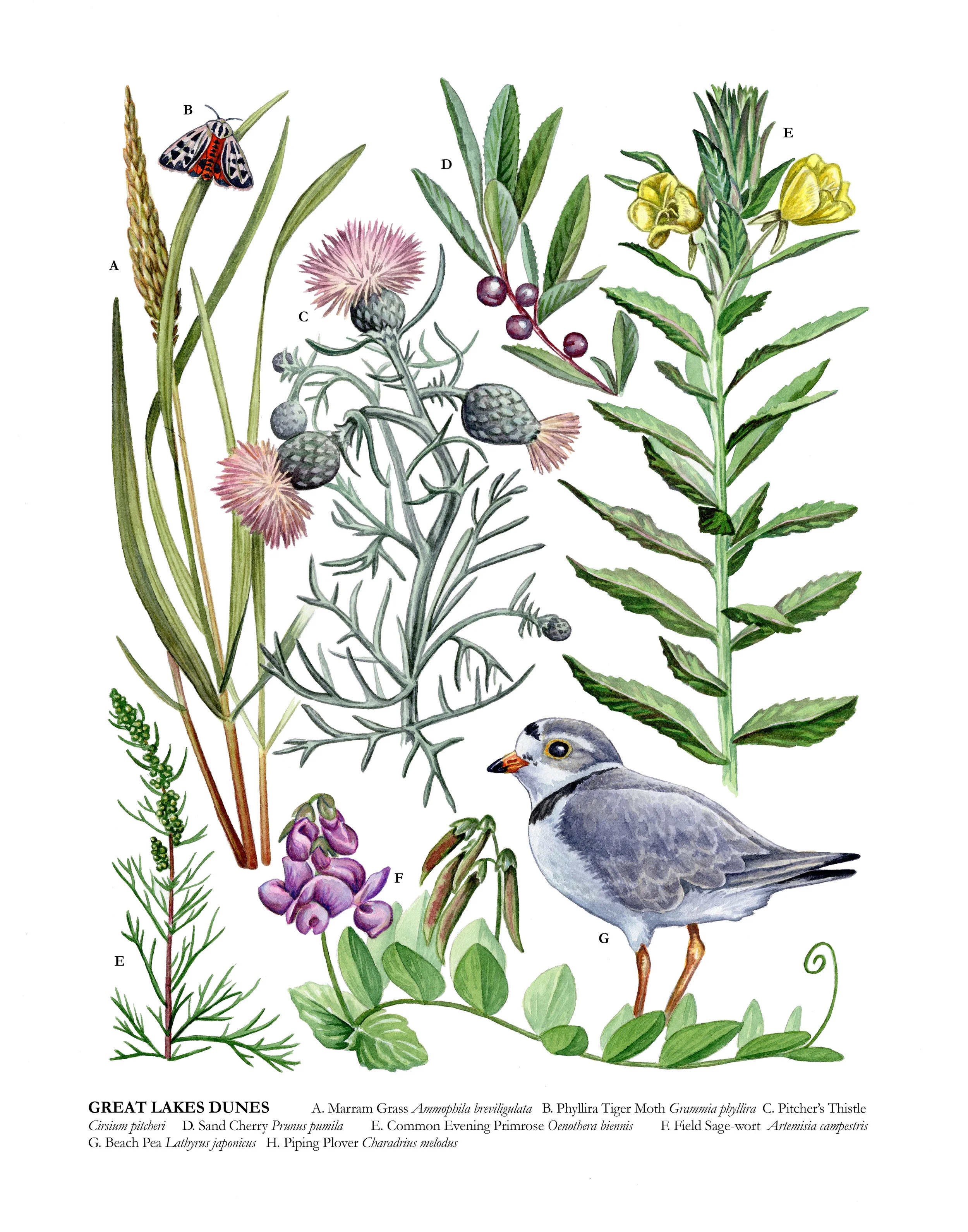
Natural Communities of Wisconsin
A series of watercolor paintings highlighting various natural communities of Wisconsin. This series was included in Natural State, a solo exhibition at the University of Wisconsin-Madison Arboretum in September/October 2018.

Calcareous Fen
This watercolor painting showcases blossoms from a Calcareous Fen. A fen is a similar to a bog, but fed by mineral-rich running surface and groundwater. This wetland community supports calciphiles, plants that grow in soil rich with calcium carbonates. The rare and endangered Swamp Metalmark butterfly is pictured with its host plant, the Swamp Thistle.

Great Lakes Dunes
Dune plants and shorebirds are familiar characters along Wisconsin’s Lake Michigan Shoreline. Cirsium pitcheri, the Pitcher’s Thistle, is endemic to dunes of the Great Lakes and listed as a Federally threatened species. The shoreline development and recreation that threaten the Pitcher’s Thistle also present an obstacle for the Piping Plover, which requires isolated beach and dune habitats for successful nesting.

Shrub-Carr
A shrubby border often serves as a transition between open wetlands and a forested community, or as a band around ponds or lakes. This habitat is a favorite haunt of the Gray Catbird, whose noisy calls alert the presence of intruders.

Northern Mesic Forest
North of Wisconsin’s climatic tension zone, the landscape transitions into mixed deciduous/coniferous forest. A range of plants in the groundlayer emerge in spring for the shorter growing season of the north. The Black-Throated Green Warblers nest in these northern forests; although they can be difficult to spot, their persistent, buzzy song fills the air.

Southern Mesic Forest
South of Wisconsin’s climatic tension zone, broad-leaf deciduous forests were historically interspersed with open prairie and savanna communities. The Wood Thrush favors mature forests with an open floor of leaf litter where they forage for invertebrates. Their fluting song floats through the forest at dusk and dawn.

Oak Savanna
The Oak Savanna is characterized by scattered, open-grown oaks with wide-spread limbs, surrounded by grasses and forbs. This community was historically maintained by wildfires that suppressed the encroachment of woody plants. Eastern Bluebirds thrive in this semi-open habitat.

Pine Barrens
Wisconsin’s Pine Barrens have a fascinating story to tell about the dynamic nature of plant communities, as well as how human activity impacts the natural landscape. Pine Barrens , once common, are dry, sandy savannas with scattered trees (notably the Jack Pine). The disappearance of this community on the landscape is largely due to the lack of fires that historically cleared the canopy. Kirtland’s Warblers, which nest in stands of young Jack Pine, depend on the resotration efforts of humans to maintain this suitable breeding habitat.

Wet-Mesic Prairie
Dominated by grasses, sedges, and forbs, prairies were historically maintained by frequent wildfires. Prairies are home to a diverse community of plants that attract birds, butterflies, and other pollinators. The Compass Plant, growing well over 6 feet tall, is so named for the orientation of leaf faces to a reasonably reliable north-south direction. With the loss of much of the Midwest’s native prairie, birds such as the Bobolink now often inhabit pastures and agricultural fields.

Wetland Plants
Wetlands such as marshes play an important role in an ecosystem: they increase water quality, protect shorelines, and provide habitat for many species of migrating birds and other animals. Many of Wisconsin’s original wetlands have been lost, increasing the need for conservation and restoration.

Inland Seepage Lake
With a landscape shaped by the glaciers that retreated thousands of years ago, Wisconsin holds over 14,000 inland lakes. Aquatic plant communities are the foundation of a lake’s ecosystem. They provide food and cover for fish, invertebrates, and other animals, and play a key role in water quality and erosion control.

Spring Wildflowers
In early Wisconsin spring, a number of perennials emerge and blossom in full glory before going dormant and disappearing for the rest of the summer just as other plants are beginning to emerge. These are known as spring ephemerals. This collection includes several spring ephemerals along with other springtime favorites. The Eastern Skunk Cabbage is able to generate its own heat to grow through melting snow and frozen soil, making it one of the first plants to watch for.
